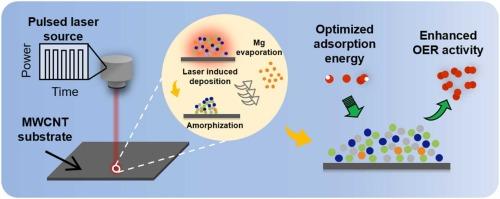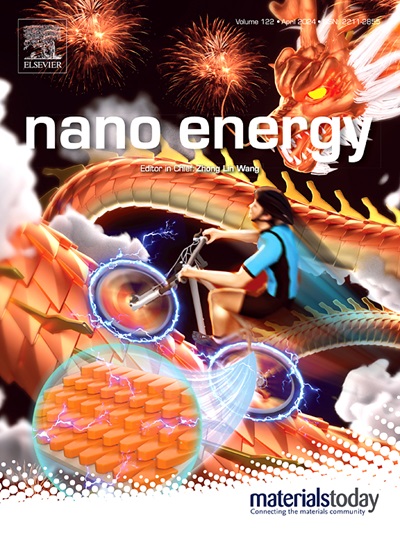Mg-evaporation induced amorphous multi-principal element alloys for advanced oxygen evolution reaction
IF 17.1
1区 材料科学
Q1 CHEMISTRY, PHYSICAL
引用次数: 0
Abstract
Multi-principal element alloys (MPEAs) have been recognized as emerged electrocatalysts that facilitate the high efficiency for oxygen evolution reaction (OER). With the noble metals free, they are cost-effective and a potential candidate to replace the traditional RuO2 and IrO2. The catalysis can be further improved through the construction of their lattice structures. This study proposes an innovative approach which makes use of pulsed laser irradiation to synthesize nano-sized amorphous MPEA particles. The low-boiling-point element Mg is incorporated with Fe, Co and Ni to synthesize MPEAs (FeCoNi)1-xMgx (x = 0.05, 0.15, 0.25, 0.35). The high thermal temperature generated during the interaction between the laser beam and MPEAs gives rise to the evaporation of Mg leading to the amorphization. The increase of Mg content intensifies the amorphization extent. (FeCoNi)0.65Mg0.35 achieves a lower overpotential (256 mV@10 mA/cm2) for OER compared to the crystal counterparts and demonstrates long-term catalytic stability. Theoretical calculations reveal that amorphization strengthens OOH* adsorption energy due to improved charge transfer. This research provides insights into novel synthesis strategies and the catalytic mechanisms of amorphous alloys.

用于先进氧气进化反应的镁蒸发诱导非晶态多主元素合金
多主元素合金(mpea)是一种高效的析氧反应(OER)电催化剂。由于不含贵金属,它们具有成本效益,是取代传统RuO2和IrO2的潜在候选材料。通过其晶格结构的构建,可以进一步提高催化性能。本研究提出了一种利用脉冲激光辐照合成纳米非晶MPEA粒子的创新方法。将低沸点元素Mg与Fe、Co、Ni掺入合成mpea (FeCoNi)1-xMgx (x=0.05, 0.15, 0.25, 0.35)。激光束与mpea相互作用过程中产生的高温导致Mg的蒸发导致非晶化。Mg含量的增加加剧了非晶化程度。与晶体相比,(FeCoNi)0.65Mg0.35的OER过电位(256 mV@10 mA/cm2)较低,并表现出长期的催化稳定性。理论计算表明,由于电荷转移的改善,非晶化增强了OOH*的吸附能。本研究为非晶合金的新合成策略和催化机理提供了新的见解。
本文章由计算机程序翻译,如有差异,请以英文原文为准。
求助全文
约1分钟内获得全文
求助全文
来源期刊

Nano Energy
CHEMISTRY, PHYSICAL-NANOSCIENCE & NANOTECHNOLOGY
CiteScore
30.30
自引率
7.40%
发文量
1207
审稿时长
23 days
期刊介绍:
Nano Energy is a multidisciplinary, rapid-publication forum of original peer-reviewed contributions on the science and engineering of nanomaterials and nanodevices used in all forms of energy harvesting, conversion, storage, utilization and policy. Through its mixture of articles, reviews, communications, research news, and information on key developments, Nano Energy provides a comprehensive coverage of this exciting and dynamic field which joins nanoscience and nanotechnology with energy science. The journal is relevant to all those who are interested in nanomaterials solutions to the energy problem.
Nano Energy publishes original experimental and theoretical research on all aspects of energy-related research which utilizes nanomaterials and nanotechnology. Manuscripts of four types are considered: review articles which inform readers of the latest research and advances in energy science; rapid communications which feature exciting research breakthroughs in the field; full-length articles which report comprehensive research developments; and news and opinions which comment on topical issues or express views on the developments in related fields.
 求助内容:
求助内容: 应助结果提醒方式:
应助结果提醒方式:


